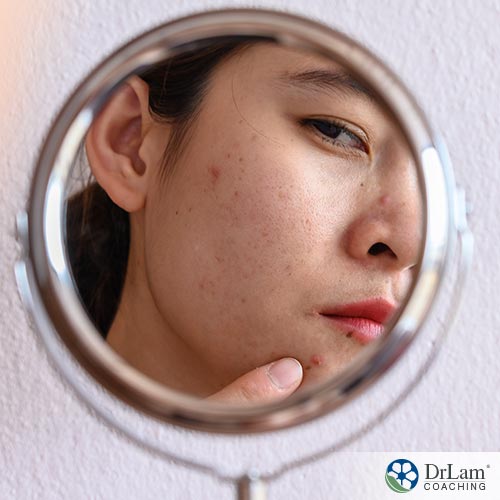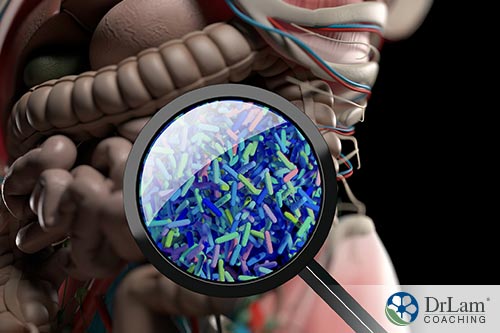 Almost everyone knows the disappointment and stress caused by an acne outbreak. Especially adults. Acne supposedly appears when you reach puberty and hormones rage. But once you’re past that stage of life, you can still get acne outbreaks. Much of the time these outbreaks come as a result of stress and carry the label of low cortisol acne.
Almost everyone knows the disappointment and stress caused by an acne outbreak. Especially adults. Acne supposedly appears when you reach puberty and hormones rage. But once you’re past that stage of life, you can still get acne outbreaks. Much of the time these outbreaks come as a result of stress and carry the label of low cortisol acne.
Low cortisol acne comes as a result of the link between chronic stress and your skin.
Your skin reflects what goes on inside your body. With increased stress, your adrenal glands may become fatigued as is Adrenal Fatigue Syndrome (AFS). As a result, they can no longer produce and release sufficient amounts of cortisol to fight the effects of stress. This leads to low levels of cortisol in your body.
Low cortisol levels can lead to increases in testosterone in both males and females. Increased testosterone combined with stress leads to low cortisol acne outbreaks.
Simply stated, acne comes as a result of the inflammation of the sebaceous glands in your skin that produce oil to keep your skin soft and supple. All ages can experience acne, even infants. When it occurs in adolescents and adults, it contributes to low self-esteem.
In the period of life when acne most often occurs, adolescence, the body undergoes a surge in hormone production. Consequently, the levels of male sex hormones, called androgens, increase dramatically. These androgens, testosterone included among them, stimulate the production of sebum, an oily lubricant for the skin and hair, and a type of protein called keratin. Sebum often becomes so abundant at this time that it clogs up pores in the skin.
Dirt and oil get trapped in the pores due to this clogging. Blackheads form in this manner. Whiteheads appear when skin scales become caught in the sebum under the skin surface. Sometimes, large numbers of whiteheads gather, spread under the skin, and rupture. This leads to inflammation and redness.
Recent research shows a clear connection between low cortisol acne and diet. Large amounts of refined carbohydrates in your diet can lead to changes in insulin resistance and imbalances of hormones. Both of these conditions carry a strong connection to increased acne.
A strong connection between testosterone levels and insulin resistance shows in the connection between highly processed foods, sugary foods, and increased levels of insulin. These foods bring about increased insulin to levels higher than average. As a result, the liver’s ability to produce Sex Hormone Binding Globulin, which limits testosterone’s ability to perform, becomes reduced. This releases more testosterone into the bloodstream, resulting in increased low cortisol acne.
The increased testosterone causes higher sebum production in the skin. Consequently, more oil clogs the skin’s pores providing a rich environment for Propionibacterium acne, the acne-causing bacteria, to colonize and spread.
Any source of stress can lead to AFS. Stress triggers the adrenal glands to produce and release cortisol to fight the effects of stress. As stress continues and becomes chronic, your adrenals can’t keep up with the demand for more cortisol. Therefore, they become fatigued. As a result, the variety of sometimes vague symptoms of AFS begin.
With chronic stress, the receptors in sebum-producing cells become highly sensitized to the stress hormones released. This stimulates the production of more sebum, resulting in more clogged pores and more acne.
The stress hormones released by your adrenals interact with other hormones in your body such as testosterone and estrogen. When the levels of stress hormones fluctuate, they affect the levels of other hormones as well. With this fluctuation, an imbalance occurs especially between cortisol and the two sex hormones, testosterone and estrogen.
The relationship between cortisol and testosterone becomes one of competition in the face of stress. Cortisol enters the bloodstream to fight the effects of stress. In addition, it lowers the action of testosterone by lowering the sensitivity of the hormone receptors for this hormone. To clarify, the higher the level of cortisol, the lower the level of testosterone. In the same vein, when cortisol levels diminish due to adrenal fatigue, the level of testosterone increases.
Testosterone increases the production of sebum, leading to more likelihood of clogged pores. Therefore, low cortisol acne appears.
The relationship between cortisol and estrogen appears a bit more complex. Under conditions of increased and chronic stress, the production of progesterone by the adrenals becomes less due to the need for more cortisol. Your adrenals produce cortisol from progesterone.
Reducing the level of progesterone in favor of cortisol leads to a relative estrogen dominance since progesterone balances estrogen. When estrogen levels increase, the production of cortisol-binding globulin increases. As a result, less cortisol becomes available to fight stress and more pressure hits your adrenals.
In addition, less cortisol in the bloodstream leads to an increase in levels of testosterone. The more testosterone, the greater the risk of developing low cortisol acne.
In the same vein, high estrogen levels negatively impact both thyroid and adrenal function. This develops into a vicious cycle of high estrogen leading to thyroid dysfunction and AFS, which both lead back to estrogen dominance.
As with so many health issues, dealing with low cortisol acne becomes a multi-faceted project. With no single cause of this condition, there is no single way to handle it adequately. The following are some tips on dealing with this condition.
Above all in dealing with low cortisol acne, you need to lower your stress level. Stress forms the foundation for AFS, the condition that brings on low cortisol in the first place. While you can’t remove stress completely from your life, you can take steps to reduce it.
Exercise, meditation, and yoga all can work toward reducing your overall stress. As with most things, these should remain at moderate levels or they can become sources of stress themselves. In addition, you’re looking at making a lifestyle change, so results will not likely come quickly. Be patient. Give yourself time to make these changes and for results to appear.
 Antibiotics are very effective in doing their job of killing bacteria. However, the downside is that antibiotics kill all bacteria, both good and bad. This can lead to an imbalance in your microbiome in which unhealthy bacteria can become dominant. As a result, a condition called ‘leaky gut’ may develop, setting in motion a dramatic increase in the level of inflammation in your body.
Antibiotics are very effective in doing their job of killing bacteria. However, the downside is that antibiotics kill all bacteria, both good and bad. This can lead to an imbalance in your microbiome in which unhealthy bacteria can become dominant. As a result, a condition called ‘leaky gut’ may develop, setting in motion a dramatic increase in the level of inflammation in your body.
Likewise, your ability to absorb nutrients may become reduced along with constipation. One of the results of this combination is an increase in waste in your body which contributes to the development of acne.
Much of the time people who suffer from low cortisol acne also eat a diet high in refined carbohydrates and sugars. These types of diets frequently also contain low levels of essential vitamins and micronutrients. Good nutrition leads to good skin.
A sugar-free diet with lots of Omega 3s works to give you healthy skin. Walnuts, almonds, flax seeds, fresh vegetables, fruits, oily fish, and good protein lead to healthy skin.
Foods that quickly convert to sugar lead to high levels of glucose. And this increase in glucose leads to an increase in insulin. In addition, these foods bind to collagen through a process called glycation. This works to increase the rate of aging of your skin and can make existing cases of acne worse.
Adding zinc to your supplementation helps you deal with low cortisol acne. Zinc stops an enzyme on your skin from converting regular testosterone into a more potent form called dihydrotestosterone.
Therapeutic levels of zinc serve to reduce the production of oil which clogs the pores and leads to the formation of acne. You should consult with your healthcare professional regarding zinc at the therapeutic level. This amount of zinc could bring some effect on the level of copper in your body as well. Your healthcare professional should monitor this.
Your liver holds the greatest responsibility for removing toxins from your body. Therefore, in order for it to work at its best, it must be strong. In its efforts at getting rid of toxins and waste products, your liver also deals with excess hormones that circulate in your bloodstream.
Your liver comprises a part of the detoxification circuit of the NeuroEndoMetabolic (NEM) stress response. This mechanism works to help your body rid itself of toxins that place significant stress on your body. Together with the interstitium and immune system, it helps your body deal with reactive metabolites that can become toxic.
When these metabolites overwhelm your liver causing it to function at less than its optimum, your body begins accumulating the waste products in the body. These wastes and toxins then begin affecting your skin, resulting in acne outbreaks. Cleansing your liver improves its functioning and decreases the risk of developing low cortisol acne.
While acne is a common condition at some times, low cortisol acne comes with chronic stress. For those with AFS, the risk increases. With acne, comes more stress because of the blow to self-esteem. This then increases your overall stress, leading to an increased risk of acne outbreaks.
If you are suffering from low cortisol acne, here are a few things you can do to alleviate the situation:
 Decrease your overall stress through relaxation methods of your choice.
Decrease your overall stress through relaxation methods of your choice.Whatever course of action you decide to take, however, please do so with the guidance of your healthcare professional who can help you with options that will work for you.
If you would like to know more about or need assistance with low cortisol acne, the team at Dr. Lam Coaching can help. We offer a free** no-obligation phone consultation at +1 (626) 571-1234 where we will privately discuss your symptoms and various options. Or you can send us a question through our Ask The Doctor system by clicking here.
Low cortisol acne can develop once your adrenals become fatigued. The low levels of cortisol seen with fatigued adrenals lead to increased testosterone. Testosterone stimulates the production of sebum which clogs the pores leading to acne. Stress, diet, and lack of micronutrients contribute to the condition.
